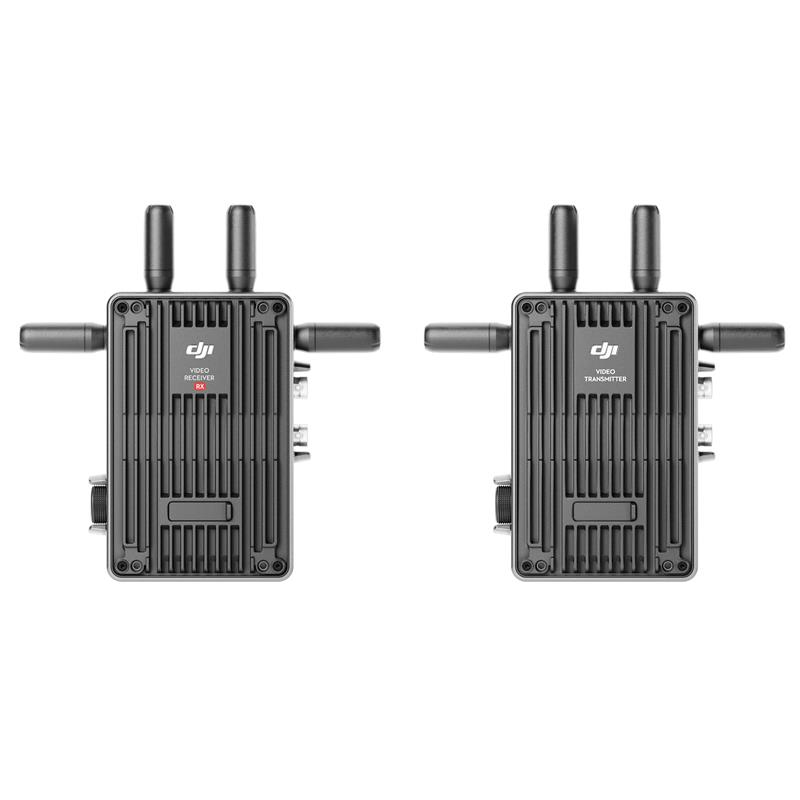
+90% in stock. Fast shipping. Free support.
DJI Transmission (Standard Combo)
DJI Transmission (Standard Combo), includes the DJI Video Transmitter and DJI Video Receiver.
This Combo offers low-latency transmission and extended range, making it especially suitable for use with production monitors.
It now also supports metadata transmission via SDI, as well as output at fractional frame rates.
DJI Transmission (Bright Remote Monitor Combo), Includes the DJI Video Transmitter and the DJI Bright Remote Monitor.
This integrated solution combines reception, monitoring, recording and control in one.
Combined with the extensive DJI PRO ecosystem, it offers a more efficient coordinated experience.
Both the Bright Remote Monitor and the DJI Video Receiver support a transmitter with multiple receivers for video and audio transmissions in two transmission modes.
The standard Broadcast Mode allows you to use an unlimited number of receivers, convenient for real-time monitoring of multiple teams, such as lighting, art and make-up departments on sets with large crews, and a live broadcast bitrate and incoming broadcast video encodings can also be displayed in real time.
If you want to switch the camera index for monitoring, simply select the corresponding index without having to check the broadcast channel, which significantly increases recording efficiency.
To connect to DJI Master Wheels or other control options, select Control Mode on the DJI Bright Remote Display or DJI Video Receiver and link it to the DJI Video Transmitter.
The DJI Ronin 2, DJI RS 3 Pro and the camera focus can then be controlled remotely from up to two reception points without affecting other devices connected via Broadcast Mode.
In addition, the DJI Video Receiver supports voice calls for real-time, one-to-one and long-distance voice transmissions, providing seamless communication between the cinematographer and the director or client.
The DJI Video Receiver supports the transmission of camera metadata via SDI.
When used with leading cinematography cameras such as ARRI, RED and others, it is capable of transmitting the filename, timecode, recording trigger, camera settings (shutter, ISO, etc.) and lens information (aperture, focal length) from the receiver to the monitors and QTAKE, allowing directors, cinematographers and TID crews to receive detailed information about recordings on set.
Compared to conventional solutions, the DJI Bright Remote Monitor integrates a high-brightness monitor with an integrated receiver, providing optimal portability and efficient setup to help you get up and running quickly on any set.
The remote monitor comes with an integrated image processing chip that is the same as the one used in the DJI Ronin 4D.
This allows it to offer many features beyond monitoring for efficient, integrated receiving, monitoring, control and recording.
The DJI Bright Remote Monitor comes with support tools such as safety zone, frame guide, zebra patterns, false colors, focus peaking, waveform and 2-touch zoom, as well as monitor color calibration and custom 3D LUT for composition, exposure and focus.
The DJI Bright Remote Monitor has a microSD card slot, allowing independent recording and storage of live broadcasts with H.264 at up to 1080p/60 fps.
The remote monitor is able to start and stop recordings automatically in synchronization with the camera, making it easy to edit proxies directly on set.
When several remote monitors are used together, each monitor is able to record or play back recordings separately without interfering with the other monitors.
The DJI Bright Remote Monitor has a protective expansion frame.
When used with the DJI Ronin 4D Handgrips, the joystick is able to control the DJI Ronin 2 or DJI RS 3 Pro stabilizers and the Focus Wheel is able to control focus and the adjustment of camera parameters such as aperture, shutter and ISO, while the record button controls the start/stop of recording, making the DJI RS 3 Pro user experience similar to that of the DJI Ronin 4D.
Both the DJI Video Receiver and the DJI Bright Remote Monitor can be used with DJI Master Wheels to achieve more advanced stabilizer control when using the DJI Ronin 2 or RS 3 Pro.
In this scenario, the original equipment will transmit the control signals directly via DJI Transmission, without the need for additional antenna mounting on the DJI Master Wheels.
This increases transmission performance threefold and improves the range and stability of the signal and anti-interference features.
DJI bright remote monitor with DJI Master WheelsDJI video receiver with DJI Master Wheels
With the DJI LiDAR (RS) Telemetry Sensor for the DJI Transmission Multi-Input Cable, you can connect the DJI Video Transmitter to the DJI LiDAR (RS) Telemetry Sensor and the DJI RS Focus Motor (2022) to experience an independent focus and monitoring system and achieve lens calibration and autofocus with a manual lens without the need to connect to the DJI RS 3 Pro.
Connect it to the DJI Ronin 4D Handgrips and you can use the LiDAR waveform to facilitate precision manual focusing.
What"s more, connecting it to the DJI RS 3 Pro offers a complete set of recording solutions that integrates stabilization, remote monitoring, stabilizer control and LiDAR focus.Without the stabilizerWith the stabilizer.
Specifications
3G-SDI output port - Supports video output in 1080p/60 fps.
HDMI 1.4 type A output port - Supports 1080p/60 fps video output.
6.8 V to 17.6 V power input (including CAN input and output and connection to DJI Master Wheels and DJI Force Pro).
HDMI 1.4 type A output port - Supports 1080p/60 fps video output.
3G-SDI output port - Supports video output in 1080p/60 fps.
WB37 power supplyThe DJI Video Transmitter, DJI Bright Remote Monitor and DJI Video Receiver are compatible with the DJI WB37 Battery.
NP-F power supplyThe DJI Video Transmitter, DJI Bright Remote Monitor and DJI Video Receiver can use the included NP-F Battery